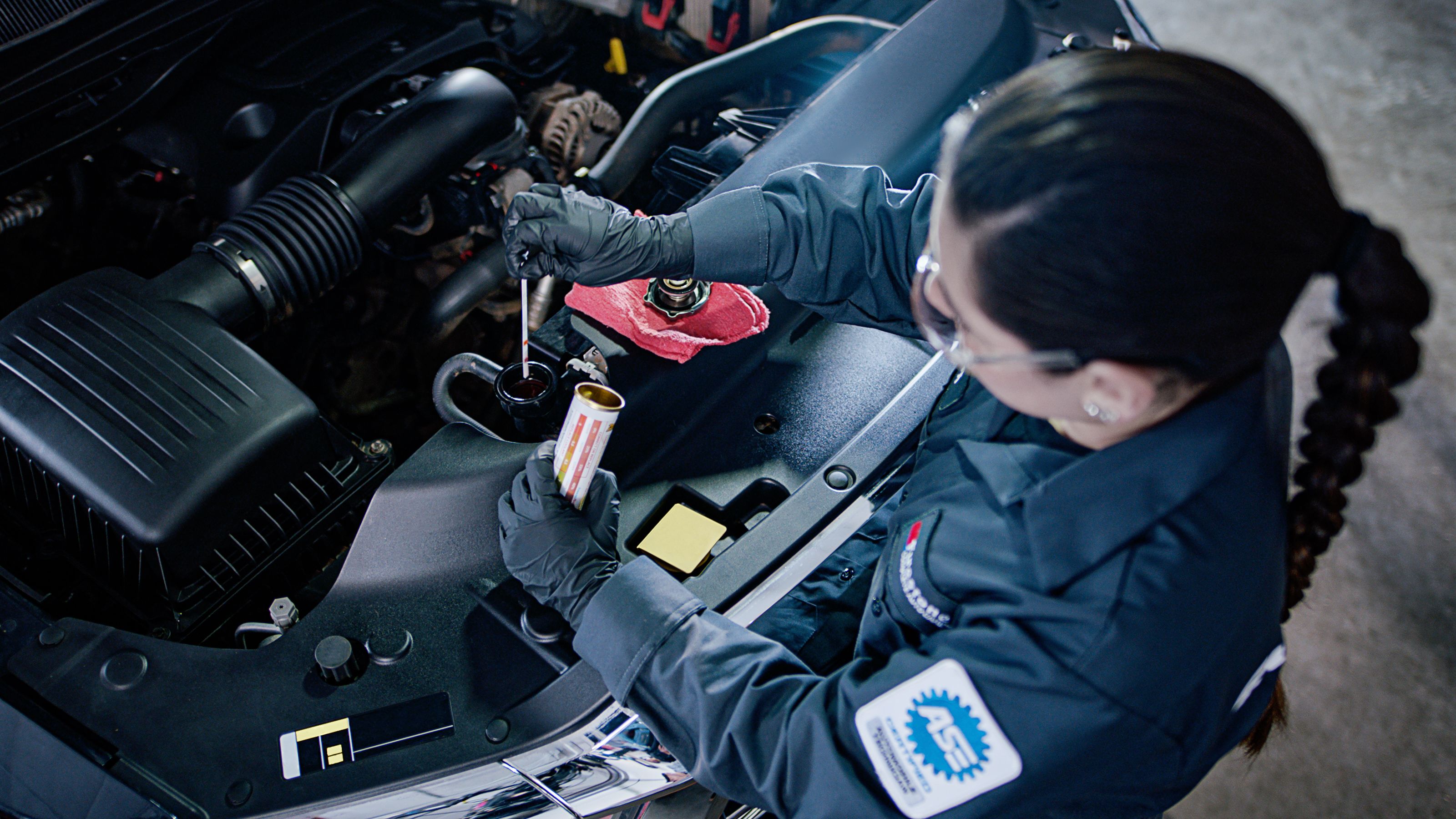You’re thankful your car A/C helps keep the cabin cool on sweltering summer days. But do you understand how the A/C system works and how to keep it maintained? This guide covers the nitty gritty details of your vehicle’s A/C to help you catch problems early on and keep it in excellent shape.
How Does a Car A/C System Work?
Believe it or not, there’s no ice machine hidden inside your car A/C. That blast of chilly air is actually hot air with the heat removed during a multi-step process.
When you turn the A/C on, the compressor compresses the system’s refrigerant, raising its pressure and temperature. The refrigerant loses heat as it flows through the condenser. Typically, it then passes through the receiver/dryer, where contaminants and moisture are removed.
Then, it’s on to the expansion valve. Here, the refrigerant loses pressure and temperature as it enters the evaporator, chilling it.
The evaporator is like a mini radiator in the dashboard. Air gets blown through the chilled evaporator, which cools and removes moisture from the air. The ventilation system blows that cool, dry air into the passenger compartment. Your air conditioning system works hard so you can get that refreshing, cold air.
How Often Should My A/C Be Inspected?
There’s no set schedule for inspecting your A/C — it’s all about how the system feels. Are you refreshed and cooled with full airflow when your vehicle's A/C is pumping? If you answered, “Yes, I am as cool as a cucumber,” you can cross A/C inspection off your list.
Do you fall into the “my A/C is not cold enough” or the “my A/C doesn’t work in the heat” side of the spectrum? Don’t sweat; stop in for an A/C Performance Check, and we’ll have you back on those hot summer streets cooler than ever.
How Often Do I Need My A/C System Recharged?
Modern air conditioning systems don’t need to be recharged on a set schedule. Most drivers can go years before needing one. However, you’ll likely notice when it’s time for a recharge. Signs your A/C might need to be recharged include hot or warm air coming from the vents, refrigerant leak, weird smells coming from the vents, and an A/C clutch that won’t engage. (We'll cover all of these potential symptoms below!)
If you experience any of these problems, visit your local Firestone Complete Auto Care for an A/C Performance Check. Our expert technicians will get to the root of the problem.
What Are the Parts of a Car A/C?
To help keep your cabin cool, your A/C relies on several components. Let’s take a closer look at these A/C system parts and their roles in giving you that refreshing blast of cool air.
What is the A/C Compressor?
The compressor is the core, primary part of every A/C system. They control temperature output with an electrically operated clutch. This clutch turns on and off whenever you change the temperature or if the HVAC module senses it has reached the desired temperature. If the ambient air temperature drops below the programmed value, the compressor clutch may not engage.
Signs of a Worn A/C Compressor
- Oil or refrigerant leaks (a professional can use special dyes to spot a refrigerant leak)
- Strange noises coming from under the hood while the A/C is on
- Erratic or failing A/C operation
What is a Compressor Clutch?
Before the compressor turns on, a special electromagnetic clutch (the compressor clutch) engages and disengages the compressor cycle. The compressor clutch engages the compressor, turning it on or off when commanded.
Symptoms of a Failing Compressor Clutch:
- Poor A/C performance
- Inability to turn the A/C on or off
- Clutch will not engage
What is an A/C Condenser?
Consider the A/C condenser the master of turning hot refrigerant gasses into liquid. The condenser is mounted at the front of most vehicles, usually in front of the radiator. Outside ambient air passes through the condenser, condensing and cooling the hot refrigerant gas into a cool liquid refrigerant.
Signs of a Worn A/C Condenser
- Leaks
- Clogged, corroded, or damaged fins or tubes
- Poor air conditioning performance
What’s a Receiver/Drier?
The receiver/drier is found on vehicles with a thermal expansion valve. It’s the safety net responsible for helping trap and prevent harmful debris and moisture from reaching the compressor and other vital A/C parts. The receiver/drier should be replaced anytime the A/C system is opened for repair or if a technician determines moisture or debris has damaged your receiver/dryer performance.
Symptoms of a Worn Receiver/Drier:
- Poor air conditioner performance
- Moisture on glass and/or inability of defroster to remove moisture from glass and windows
What is an Accumulator?
An accumulator is similar to a receiver/drier but is only on vehicles with an orifice tube. If you have an accumulator, you do not have a thermal expansion valve.
The accumulator:
- Monitors and controls the amount of refrigerant that enters the evaporator
- Stores excess refrigerant so that it cannot enter and damage the compressor
- Filters debris and removes moisture from the A/C System
You will need to replace the accumulator if the A/C system is opened for repair or if a technician determines moisture or debris has damaged your accumulator’s performance.
What is a Thermal Expansion Valve/Orifice Tube?
The orifice tube or thermal expansion valve is located between the condenser and the evaporator. It constantly monitors the pressure and temperature of your A/C system to determine the exact amount of refrigerant that can safely enter your evaporator. If too much or too little refrigerant enters the evaporator, you could have a big problem.
An orifice tube may also contain a fine mesh screen to block contaminants from the rest of the system.
Signs You May Need a New Orifice Tube or Thermal Expansion Valve:
- Poor A/C system performance
- A technician has determined it’s dirty or clogged
What is an Evaporator?
The evaporator is located behind your dash and is responsible for cooling cabin air and removing moisture. Low-pressure refrigerant traveling through the evaporator cools it. This allows the evaporator to absorb heat from the cabin air, dropping the temperature of the air blowing out of the vents. If cold, refreshing air hits your face, the evaporator is working like a champ.
Symptoms of a Worn Evaporator:
- Poor A/C system performance
What is the Clutch Cycling Switch?
The clutch cycling switch cycles the compressor according to the pressure in the accumulator. This action helps to prevent the evaporator from freezing. Although most cars can blow air at temperatures as low as 60 degrees, the temperatures inside the evaporator core can get cold enough to freeze the entire core completely.
The clutch cycle’s job is to ensure the evaporator doesn’t reach the point of glacier temperatures.
Symptoms of a Failing Clutch Cycling Switch:
- Evaporator freezing up
- Evaportor does not get cold enough
What is Refrigerant?
Refrigerant (often referred to by the DuPont trade name Freon) is a specially formulated cooling agent that can transform from a liquid to a gas and back again. It absorbs and releases heat, ultimately leaving cool air behind.
Different devices, such as your home refrigerator, home A/C system, or vehicle, may use different refrigerants. They may or may not be the same.
What Are the Different Types of Car Refrigerant?
The three common car refrigerants are R-12, R-134a, and R-1234yf. Different refrigerant types require different charging hoses, so check which one your vehicle is it in earlier models.
- R-12: R-12 is the original chlorofluorocarbon (CFC) Freon used in car A/C systems until the mid-1990s. It was banned after the EPA discovered that it depletes the ozone layer. Vehicles manufactured pre-1995 often use R-12, but you can retrofit them with an R-134a system.
- R-134a (HFC-134a): Your vehicle likely uses R-134a (also called HFC-134a). This refrigerant surfaced to replace R-12 once its environmental dangers were discovered. While R-134a is safer than R-12, and most vehicles use it, it’s still not the safest option for the ozone. Manufacturers have recently phased it out.
- R-1234yf (HFO-1234yf): To replace the phased-out R-134a, manufacturers created R-1234yf (also called HFO-1234yf), a hydrofluoric-olefin refrigerant. R-1234yf is an even more environmentally friendly refrigerant. It should be in cars manufactured after 2021, though you may find it in earlier models.
What is a Refrigerant Charge Port?
The refrigerant service port is the connection point where new refrigerant can enter the system during an A/C system recharge or where you can remove refrigerant from the A/C system. There is a service port located on the low side and high side A/C lines. Only properly equipped, certified, and qualified persons should perform A/C recharging services. The EPA (Environmental Protection Agency) requires anyone who services automobile air conditioning systems to be EPA Section 609 Certified.
Cool Down with Firestone Complete Auto Care
The last thing you want is to sweat in your car every time you drive to work or pick up groceries. If you notice any change in your car A/C’s performance, it’s time for an inspection. Schedule an appointment with the experts at your local Firestone Complete Auto Care today.



